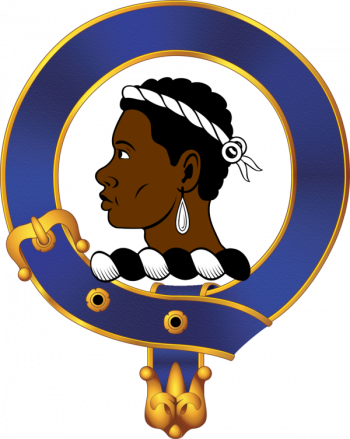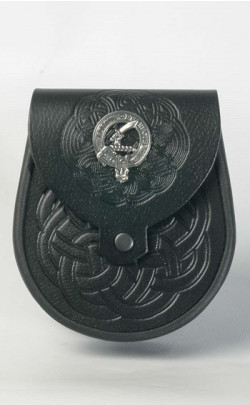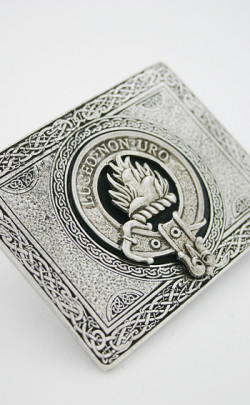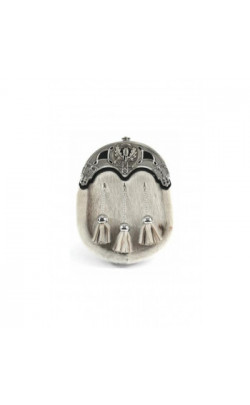
Clan Borthwick
QUI CONDUCIT
Scottish History
of Clan Borthwick
The battling Borthwicks
Mystery surrounds the origin of the Borthwick clan. The most common belief is that they assumed their name from the Borthwick Water which lies between Selkirk and Roxburgh in the Scottish Borders. The family is said to descend from a Hungarian by the name of Andreas who arrived in Scotland with the court of Edgar Aetheling and his sister Margaret.
In 1066 William of Normandy conquered England and Edgar Aetheling, who should have succeeded to the English crown but was too young, went into exile in Scotland with his mother and sisters. They had previously been living in Hungary, indeed Edgar’s mother was Hungarian, and were regally entertained by King Malcolm Canmore at his royal palace in Dunfermline. One of Edgar’s sisters, Margaret, attracted Malcolm’s eye and before long the couple were married. Andreas, as part of the royal retinue, was granted land in the south of Scotland and from there his family grew to become one of the foremost clans in the country.
Over the years Borthwicks were involved in several of the most talked about episodes in Scottish history.
When Robert the Bruce was on his death-bed in 1329 he asked that his heart be taken to the Holy Land and carried into battle against the “Infidels” because he had never gone on a Crusade. Sir James Douglas volunteered to carry out the king’s final wish. Bruce’s body was buried in Dunfermline Abbey but his heart was placed in a casket. In 1330 Sir James, accompanied by other Scottish nobles, including Sir William Borthwick, set off on a mini crusade from Berwick. At that time the Moors occupied southern Spain and the Spanish King Alfonso pleaded for help from foreign knights in his war against Muhammed IV, Sultan of Granada. The Scots thought it would be a great idea to join the Christian army in the battle to rid Europe of the infidels and headed for Seville, where they arrived at the end of July. On August 25 the Battle of Teba began. Douglas led the advance and was soon involved in heavy fighting. At one point the Saracens, under intense pressure, were forced to flee and in the heat of the battle Douglas chased after them until he found himself almost alone. As he turned to rejoin the main force he saw Sir William St Clair surrounded by Moors. Rather than escape, Douglas went to his friend’s rescue accompanied by a smallnumber of Scots knights. But they were soon overwhelmed. Douglas took the silver casket which housed Robert The Bruce’s heart, which he’d been wearing round his neck, and threw it towards the Moors shouting, “Now pass thou onward before us, as thou wast wont, and I will follow thee or die”. Douglas and the knights who surrounded him were all killed. King Alfonso’s men eventually overpowered their enemy and in the final battle Sir William Borthwick personally beheaded the leader of the Moor forces who ambushed Douglas. To this day a Moor’s head sits in the Clan Borthwick crest. Sir William St Clair was among the knights who died alongside Douglas. The St Clairs and Borthwicks remained close through the centuries. When, in 1446, another Sir William St Clair built the sumptuous Rosslyn Chapel, the home of the Knights Templars who featured in the film The Da Vinci Code, the first Lord Borthwick was his cupbearer. This was a position of great trust and responsibility. Lord Borthwick’s job was to serve the wine at St Clair’s table. At that time Rosslyn was famed for itsluxurious and often extravagant lifestyle. The cupbearer also had to swallow some of the wine before serving it, just to ensure it wasn’t poisoned!
Sir William Borthwick it was who was created first Lord Borthwick and he was one of the Scottish noblemen who became substitute hostages for King James I of Scotland. In 1398 King Robert III’s health had deteriorated so much that the Scottish Parliament appointed his oldest son, David the Duke of Rothesay, to rule in his place. David had two very powerful uncles, both brothers to his father. One, Robert Stewart, the Duke of Albany, had his eye on the throne and in 1402 led a coup against David. He was helped by the Earl of Douglas and the pair imprisoned David in Falkland Palace. Two months later David was found dead. Albany stated that the death was “by divine providence and not otherwise”. But it later emerged that the 24-year-old captive had starved to death on his uncle’s orders. King Robert had a younger son, James, who was born in 1394. Robert tried to protect him from Albany by sending him into hiding abroad. First James holed up at Dirleton Castle, East Lothian then on the Bass Rock on the coast just off North Berwick. From there he hoped to make his way to France. A merchant ship agreed to take him to the continent but it was boarded by pirates off Flamborough Head and James was seized and handed over to Henry IV of England. Exactly two weeks later, on April 4, 1406 Robert III died, heartbroken at the fate that had befallen his sons, and James I at the tender age of 12 was crowned king of Scotland. There was only one problem for James, he was a prisoner, although in some luxury, at Windsor Castle. The Scottish Parliament, meanwhile, appointed his uncle Robert, the Duke of Albany, as Governor of Scotland. James was to spend 18 years incaptivity. Then in 1423 the Treaty of London was signed. It provided for the release of James I in return for a ransom of £40,000 and the provision of 21 hostages as security until the money was paid. Under the terms of the treaty James had six years to pay in full and the hostages, all noblemen and including Lord Borthwick had to wait thefull term before being set free. On his return to Scotland in around 1430 Lord Borthwick built a castle just outside Edinburgh so well it is still in existence today. It’s not surprising it has lasted so long. The walls at the castle’s base are thirteen feet thick, narrowing to six feet at the top and the structure was 110 feet high.
In 1511 the French were under attack from the Holy League, a military alliance which included the Papal States, Spain, the Holy Roman Empire and England among others. They approached King James IV of Scotland in the hope of resurrecting the Auld Alliance. In return for supporting his crusades to the Holy Land and his claim on the English throne, he agreed. In September 1513 Scottish forces marched into England from Edinburgh and, having disposed of resistance just south of the border, encamped on Flodden Hill. Despite positional and numerical advantage the Scots, missing their most able gunners who had been despatched to the aid of the French, were annihilated. James and his son Alexander, who was the Bishop of St Andrews, died along with two abbots, 11 earls, 15 lords and at least 10,000 others. Among them was William, the fourth Lord Borthwick who fought alongside his king. Another Borthwick played a prominent role in the battle. Robert Borthwick was the Scottish king’s master gunner and had been responsible for designing and manufacturing seven huge canons, known as “The Seven Sisters”. They were originally positioned in Edinburgh Castle but were moved by James to Flodden, where even their presence was not enough to save the Scots. The fifth Lord Borthwick, also William, was rewarded for his father’s loyalty. He was given command of Stirling Castle and was made responsible for the safety of the infant king James V who was born just a year before Flodden.
Loyal and true
The Borthwick’s loyalty to the Scottish monarchy continued during the turbulent rule of James V and after his death when his daughter, Mary, Queen of Scots, became heir to the throne in the mid sixteenth century. She had been crowned not long after her birth in 1542.Her mother, Mary of Guise, was a French aristocrat and she wanted her daughter to enjoy the same benefits she’d received from a strict Roman Catholic upbringing. At that time, though, a tide of Protestanism was sweeping through Scotland, led by John Knox. Lord John Borthwick was a powerful land owner. He was not in favour of the Reformation and openly supported Mary of Guise. Despite those strong, but unpopular, religious sympathies he found himself excommunicated. He had dared criticise the church and was found guilty of contempt of the Ecclesiastical Court of the See of St Andrews. William Langlands, an officer of the court, was sent to Borthwick Castle to deliver the letter of excommunication. However, he was intercepted by the Lord’s friends and thrown in the mill dam south of the castle. Once he had dried he was made to eat the letters, which had by now been soaked in wine. The unfortunate Langlands was sent back to St Andrews with a warning that any future attempts to excommunicate his Lordship would be met in the same way.
In 1548, in line with her mother’s wishes, Mary, Queen of Scots was sent to France where at the age of 16 she married the Dauphin Francis who was heir to the French crown. On his death two years later in 1560 she returned to Scotland to take the throne. Mary ensured her popularity by doing little publicly to hinder the pace of the reformation, while celebrating mass in private. But she made her first big mistake in 1565 when she married her cousin Lord Darnley. He was younger than her and immature for a 19-year-old. He was unpopular with the other nobles and had a mean and violent streak. Within a short time, Mary became pregnant, but Darnley became jealous of Mary’s private secretary, David Rizzio, and murdered him. Following the birth of their son, the future James VI of Scotland, Darnley continued to offend almost everyone who crossed his path. In February 1567 he died mysteriously after an explosion at a house in Edinburgh where he’d been staying. James Hepburn, fourth Earl of Bothwell and his supporters, were suspected of carrying out the killing. Mary herself was implicated, like she had been after the murder of Rizzio. Mary later married Bothwell, who had abducted her and imprisoned her for a week. There were rumours that he had raped her, thus forcing her to marry him. All of these events led to a public outcry and the Scottish nobility responded by challenging her right to rule. Matters came to a head in June 1567. At that time, one of Mary’s closest friends and confidants was William, sixth Lord Borthwick. On June 7 Mary and Bothwell fled to Borthwick Castle, where they spent what was to be their last night together. Their host tried to protect the fugitives but forces led by the Earl of Morton and Lord Home tracked them down. While negotiations took place Mary slipped out of the castle under the cover of darkness disguised as a page boy. She eventually made her way to England where she was imprisoned and executed in 1587. Borthwick Castle, just outside Edinburgh near Gorebride, has been turned into a luxury hotel. Visitors can spend the night in the same room shared by Mary and Bothwell all those years ago.
The ninth Lord Borthwick, John, maintained the family’s adherence to the royalist cause. During the third English Civil War the Scots declared their loyalty to King Charles II of England, who had been proclaimed King in Scotland in 1649. About 18 months later, in September 1650, The English parliamentary army, commanded by Oliver Cromwell defeated the Scots at the Battle of Dunbar. Cromwell then headed north and laid seige to Borthwick Castle. Lord John Borthwick held out for several days but was eventually forced to surrender. He negotiated favourable terms which allowed him and his family to leave unmolested and provided them with fifteen days to return and remove their belongings. He had previously married Lady Elizabeth Kerr, daughter of the Earl of Lothian but died in 1672 without an heir.
For the next 90 years the title was officially dormant. In 1727, however, Henry Borthwick made a claim to become the new Lord Borthwick. He was a direct descendant of Alexander Borthwick, who was the second son of the third Lord Borthwick. It wasn’t until 1762 that the House of Lords ratified his claim and Henry became the tenth Lord Borthwick. Ten years later he, too, died without heir and once again the title became dormant. It stayed that way for over 200 years, despite many claims and counter-claims by members of the Borthwick clan. Finally, in 1986 Major John Henry Stuart Borthwick was recognised by the Lord Lyon as Borthwick of that Ilk, or chief of the clan. He also became the 23rd Lord Borthwick. On his death in 1996 he was succeeded by his son, John Hugh Borthwick.
Family History Mini Book
We hope you enjoyed reading this excerpt from this mini book on the Scottish history of the Borthwick family.
You can buy the full book for only108 Clan Borthwick
Tartan Products
The Crests
of Clan Borthwick
































































